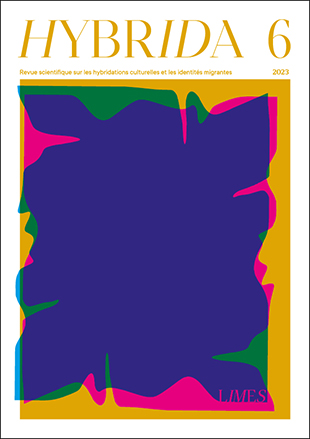Le rôle de la "frontière" dans la conceptualisation de l'identité impériale russe : une étude basée sur les prisonniers politiques polonais
DOI :
https://doi.org/10.7203/HYBRIDA.6.26243Mots-clés :
Sibérie et l’Asie centrale / Exilés polonais / « Triangle sibérien » polonais , Impérialisme russe / Postcolonialisme Résumé
Résumé
Cet article explore les subtilités de la construction et de la définition de l’identité des individus résidant aux frontières du sud et de l’est de l’Empire Russe. Les habitants de ces cités impériales et des fortifications, nichées entre deux cultures, étaient principalement constitués d’individus déplacés forcés et leurs descendants, à l’exception de ceux en service militaire ou administratif de l’Empire. La présence d’exilés polonais dans les périphéries est et sud de l’Empire Russe était une conséquence directe de sa politique expansionniste. À travers les journaux intimes, la correspondance et les travaux publiés de trois prisonniers politiques polonais – Adolf Januszkiewicz, Bronis?aw Zaleski et Seweryn Gross – nous plongeons dans les identités complexes, ambiguës et multiformes de leurs oppresseurs, les habitants des steppes et les exilés politiques eux-mêmes, tous entrelacés dans des relations coloniales complexes. Cette enquête remet en question les distinctions simplistes telles que « nous » contre « eux » et « ici » contre « là-bas ».
 Téléchargements
Téléchargements
 Références
Références
Adamczewski, P. (2019). Polski mit etnopolityczny i Kaukaz. ISP PAN.
Anderson, B. (2006). Imagined communities. Reflections on the origin and spread of nationalism. Verso.
Baliński, T., & Rakoczy, M. (2015). Antropologia szkoły: tradycje, postulaty, inspiracje. Almanach Antropologiczny Communicare, 5, 7–25. https://doi.org/10.31338/uw.9788323518075
Bassin, M. (1991). Inventing Siberia: visions of the Russian East in the early nineteenth century, American Historical Review, 96(3), 763–794. https://doi.org/10.2307/2162430
Bekmakhanov, E. (1992). Kazakhstan v 20-40 XIX veke. Kazak Universiteti.
Bhabha, H. K. (1994). The locations of culture. Routledge.
Caban, W. (2001). Służba rekrutów z Królestwa Polskiego w armii carskiej w latach 1831–1873. DiG.
Caban, W. (2006). Z Orenburga do Paryża. Bronisław Zaleski 1820-1880. Wydawnictwo Akademii Świętokrzyskiej.
Connerton, P. (1989). How societies remember. Cambridge University Press.
Cywiński, B. (2013). Szańce kultur. Szkice z dziejów narodów Europy Wschodniej. Trio.
Driver, F., & Gilbert, D. (1999). Imperial cities: overlapping territories, intertwined histories. In F. Driver and D. Gilbert (Eds.), Imperial cities (pp. 1–17). Manchester University Press.
Fanon F. (2008). Black Skin, White Masks. (Translated by C. L. Markmann) Pluto Press.
Foucault, M. (1981). The order of the discourse. In R. Young (Ed.), Untying the text: a post-structuralist reader, (pp.48–78). Routledge & Kegan Paul.
Gawrycki, M.F., & Szeptycki, A. (2011). Podporządkowanie – niedorozwój – wyobcowanie. Postkolonializm a stosunki międzynarodowe. WUW.
Gerasimov, I., Glebov, S., Kaplunovski, A., Mogilner, M., & Semyonov, A. (2012). The centrality of periphery, Introduction. Ab Imperio, (1), 19-28. https://doi.org/10.1353/imp.2012.0026
Goody, J. (2001). The logic of writing and the organization of society. Cambridge University Press.
Gramsci, A. (1971). Selection from the prison notebooks. (Edited and translated by Q. Hoare and G. Nowell Smith). Lawrence & Wishart.
Hobsbawm, E. (1989). The age of Empire 1875-1914. Vintage Books.
Janion, M. (2006). Niesamowita słowiańszczyzna. Fantazmaty literatury, Wydawnictwo Literackie.
Januszkiewicz, A. (2003). Listy z Syberii. (Ed. H. Geber). Czytelnik.
Januszkiewicz, A. (2013). Listy ze stepów kirgiskich i dziennik podróży. (Ed. H. Geber). PTL.
Jedlicki, J. (2014). The Vicious Circle 1832–1864. A History of the Polish Intelligentsia – Part 2. (translated by T. Korecki) Peter Lang.
Kaczyńska, E. (1991). Syberia: największe więzienie świata 1805-1914. Oficyna.
K[alinka], W. (1881). Z Orenburga. Przegląd Polski.
Käkitai, Tutgul Kunanbai, (1909), Qazaq aqyny Ibrahim Qunanbai ulghynyn ölni, Санкт-Петербург.
Kennan, G. (1906). Sibir’ i ssilka, V. Vrublevskogo.
Kieniewicz, S. (1977). Wpływ zaboru rosyjskiego na świadomość społeczeństwa polskiego. Dzieje najnowsze, IX – 4, 105–115. https://rcin.org.pl/dlibra/doccontent?id=50365
Khodarkovsky, M. (2004). Russia’s steppe frontier. The making of a colonial empire 1500-1800. Indiana University Press.
Kristeva, J. (1982). Powers of horror: an essay on abjection. (Translated by L. Roudiez). Columbia University Press.
Le Goff, J. (2007). Historia i pamięć. (Translated by A. Gronowska and J. Stryjczyk). WUW.
Macińska, M. (2014). At the Crossroads: 1865–1918: A History of the Polish Intelligentsia – Part 3. (Translated by T. Korecki). Peter Lang.
Malinowski, B. (2001). Prawo, zwyczaj, zbrodnia w społeczności dzikich. De Agostini Altaya.
Materialy dlya izucheniya yuridicheskih obichaev kirgizov, vip.1, materialnie pravo. (1886). Omsk.
Milewska-Młynik, A. (2012). Seweryn Gross wśród badaczy kazachskiego prawa zwyczajowego, Muzeum Niepodległości.
Mitchell, T. (1991). Colonising Egypt. University of California Press.
Simpson, Y. (1999). ‘Capital of Colonies’: real and imagined boundaries between metropole and empire in 1920s Marseilles. In F., Driver & D. Gilbert, Imperial cities (pp. 136-154). Manchester University Press.
Osterhammel, J. (2014). The transformation of the world. A global history of the nineteenth century. (Translated by P. Camiller). Princeton University Press.
Pavlenko, S. (2015). Zesłanie jako spotkanie kolonialne. Przestrzeń Uralu i Syberii w oczach Tomasza Zana. Świat Tekstów. Rocznik Słupski, (13), 5–31. https://swiattekstow.apsl.edu.pl/images/publikacja/13/pavlenko.pdf
Polish Library in Paris, manuscripts 476. (s.d).
Pratt, M. L. (1992). Imperial eyes. Travel writing and transculturation. Routledge.
Remvev, A. (2000). Regionalnie parametru imperskoy ‘geografii vlasti’ (Sibir’ i Dalniy Vostok). ab-Imperio 3–4, 343-358. https://doi.org/10.1353/imp.2000.0045
Remnev, A. (2004). Rossia dalnego vostoka. Imperskaya geografiya vlasti XIX- nachala XX vekov. OmGU.
Remnev, A. (2009), ‘Tigr zakolotiy gusinim perom’. Kazus zapadnosibirskogo general-gubernatora knyazya P.D. Gorchakova. Acta Slavica Iaponica, (27), 55–75.
Remnev, A., & Sukhih O. (2006). Kazachskie deputacii v scenariyach vlasti: ot diplomaticheskikh missiy k imperskim pretenziyam. ab-Imperio, (1), 119–154. https://doi.org/10.1353/imp.2006.0023
Sapargalijew, G., & Djakow, W. (1982). Polacy w Kazachstanie w XIX w. (Translated by A. Trombala and J. Plater). Czytelnik.
Schick, I. C. (2012). Seksualność Orientu. Przestrzeń i eros. (Translated by A. Gąsior- Niemiec). Oficyna Naukowa.
Soja, E. (1996). Thirdspace: Journeys to Los Angeles and Other Real-and-Imagined Places. Oxford
Sowa, J. (2011). Fantomowe ciało króla. Peryferyjne zmagania z nowoczesną formą. Universitas.
Spivak, G. Ch. (1994). Can the Subaltern Speak? In P. Williams, L. Chrisman L., Colonial Discourse and Post-Colonial Theory. A reader, (pp. 66–111). Colombia Press.
Stoler, A. L. (2009). Making Empire Respectable: The Politics of Race and Sexual Morality in 20th-Century Colonial Cultures. American Ethnologist 16(4), 634–660. http://www.jstor.org/stable/645114
Sunderland, W. (2003). Empire without Imperialism? Ambiguities of Colonization in Tsarist Russia. ab-Imperio 2, 101-114. https://doi.org/10.1353/imp.2003.0036
The Princes Czartoryski Library, manuscripts 6928. (s.d.).
Thompson, E. M. (2000). Imperial knowledge: Russian literature and colonialism. Greenwood Press.
Uly Abaigha adaldyk (Estelikter, maqalalar, suretti shezhireler). (2002). Semey.
Vasil’ev, D. (2014). Rossiya i Kazachskaya step’: administrativnaya politika i status ukraini XVIII-pervaya polovina XIX veka. Politicheskaya enciklopediya.
Walikhanov, S. (1904), Sochineniya Shokana Walikhanova. Zapiski Imperatorskogo Geograficheskogo Obshestva po otdeleniyu etnografii XXIX, Sankt-Perergurg.
Wallerstein, I. (2006). European universalism. The rhetoric of power. The New Press.
Zaleski, B. (2008). Wspomnienia z Uralu i stepów kazachskich. (Ed. A. Zieliński). PTL.
Téléchargements
Publiée
Comment citer
-
Résumé199
-
HTML 216
-
PDF 123
Numéro
Rubrique
Licence
![]()
Tous les documents de la plateforme OJS sont en libre accès et propriété de leurs auteurs respectifs.
Les auteurs publiant dans la revue acceptent les conditions suivantes :
- Les auteurs conservent les droits et garantissent à HYBRIDA le droit d'être la première publication du document, sous licence de Creative Commons d'Attribution - Pas d’Utilisation Commerciale - Partage dans les Mêmes Conditions 4.0 International (CC BY-NC-SA 4.0) qui permet à d'autres de partager le travail avec une reconnaissance de l'auteur et de la publication dans le journal.
- Les auteurs sont autorisés et encouragés à diffuser leur travail (une fois publié) par voie électronique en utilisant des sites Web personnels ou institutionnels (archives ouvertes institutionnelles, sites Web personnels ou profils de réseaux professionnels et universitaires) une fois le texte publié.
















